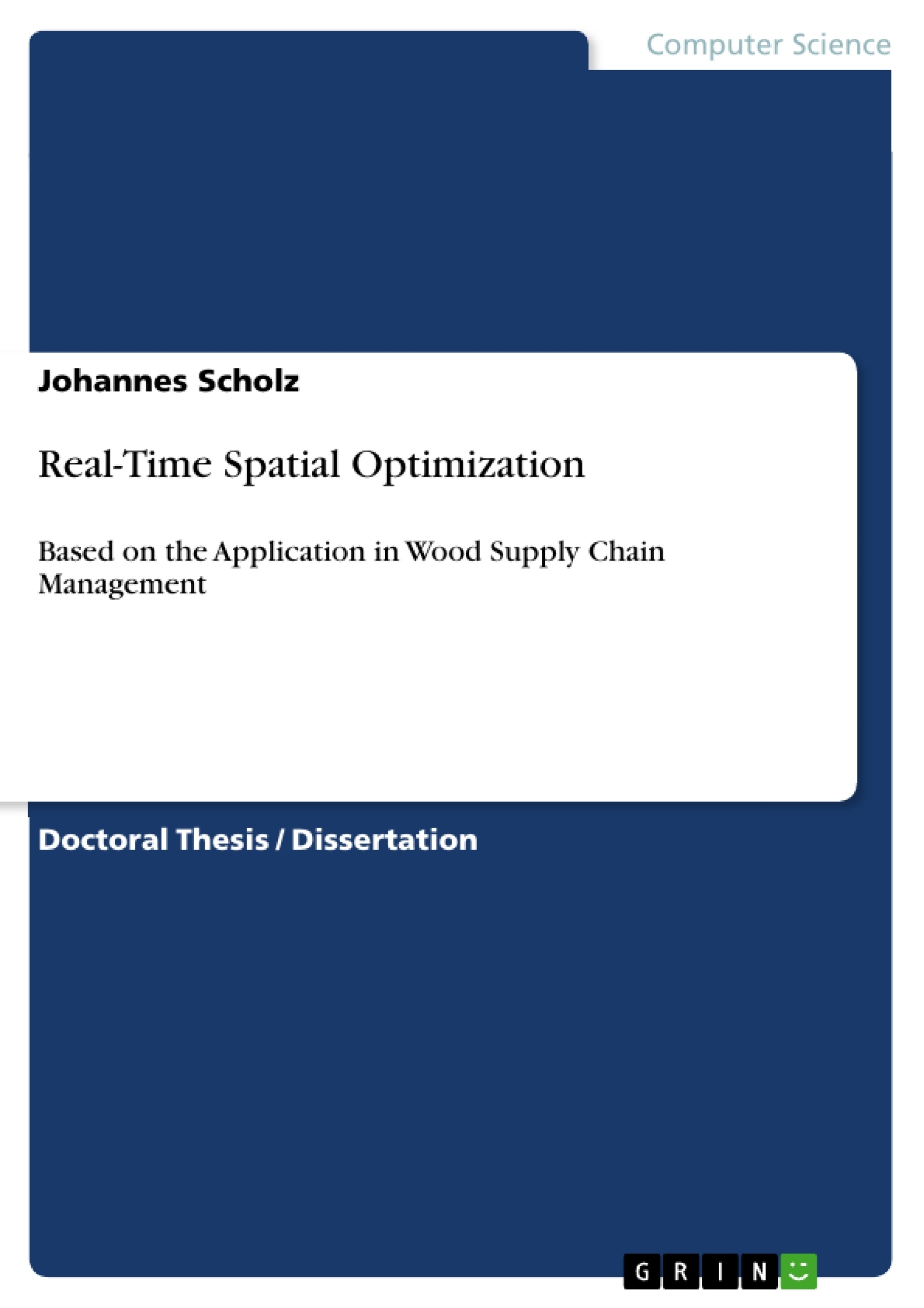The application of real-time spatial optimization in a Spatial Decision Support System, utilizing Geographic Information Science and Technology, is shown using the example of Wood Supply Chain management. Interdisciplinarity is a key concept, because Geographic Information Science, Operations Research and Spatial Decision Support Systems are bundled together. Service Oriented Architectures allow the development of an architecture that consists of several - even spatial - dispersed hard- and software. This approach guarantees a fail safe architecture and paves the way for Ubiquitous Computing and Spatial Data Infrastructures. In addition, spatial data can be gathered and sent out in real-time from/to mobile devices utilizing Location based Services. The dissertation proves, that a specific spatial problem can be solved using mathematical modeling and an appropriate optimization technique. In this work Adaptive Large Neighborhood Search is used. By the fact that the optimization is enveloped in a Spatial Decision Support System, decision makers are involved in the decision process. On the one hand they are able to alter model parameters which alter the optimization process at hand, and on the other hand they can choose one decision alternative recommended by the system. This dissertation shows - based on example of Wood Supply Chain management - that real-time spatial optimization is able to successfully "solve" a spatial problem when coupled with a Spatial Decision Support System.
Inhaltsverzeichnis (Table of Contents)
- Abstract
- 1 Introduction
- 2 Fundamentals of Spatial Optimization
- 2.1 Geographic Information Science and Technology
- 2.1.1 Spatial Data Acquisition
- 2.1.2 Spatial Data Storage
- 2.1.3 Spatial Data Manipulation
- 2.1.4 Spatial Data Visualization
- 2.1.5 Spatial Data Analysis
- 2.2 Service Oriented Architectures
- 2.2.1 Concepts of Service Oriented Architectures
- 2.2.2 Interoperability and Standards
- 2.2.3 Location Based Services
- 2.3 Graph Theory and Optimization
- 2.3.1 Graph Theory
- 2.3.2 Vehicle Routing Problem
- 2.3.3 Optimization Techniques
- 2.4 Spatial Decision Support Systems
- 2.4.1 Concepts of Spatial Decision Support Systems
- 2.4.2 Decision Support System Architecture
- 3 Implementation and Application
- 3.1 Problem Definition
- 3.2 System Design
- 3.3 Real-Time Spatial Optimization System
- 3.4 Case Study
- 3.4.1 Data Collection and Analysis
- 3.4.2 Optimization Results
- 4 Conclusions
- 5 Outlook
Zielsetzung und Themenschwerpunkte (Objectives and Key Themes)
This doctoral thesis investigates the concept of real-time spatial optimization, a process that combines Geographical Information Science and Technology with Operations Research, to generate optimized solutions for spatial problems in real-time. The main objective is to develop a real-time spatial optimization system that can be applied to various spatial problems, particularly in the context of Wood Supply Chain management.
- Geographic Information Science and Technology foundations for spatial data acquisition, storage, manipulation, visualization, and analysis.
- Service Oriented Architectures and their application in developing a real-time spatial optimization system, with an emphasis on interoperability and Location Based Services.
- Graph theory and its application in modeling the Wood Supply Chain management problem, specifically the Vehicle Routing Problem with Pickup and Delivery and Time Windows.
- Optimization techniques, including exact and approximate algorithms, for solving the Wood Supply Chain management problem. Adaptive Large Neighborhood Search is selected as an appropriate optimization technique.
- Spatial Decision Support Systems and their role in supporting decision-makers in complex, semi-structured problems, such as Wood Supply Chain management.
Zusammenfassung der Kapitel (Chapter Summaries)
Chapter 1 provides an introduction to the research topic, outlining the motivation and scope of the thesis. It discusses the relevance of real-time spatial optimization in various fields, particularly in Wood Supply Chain management.
Chapter 2 delves into the fundamental concepts underpinning real-time spatial optimization. It explores Geographic Information Science and Technology, Service Oriented Architectures, Graph Theory, Optimization techniques, and Spatial Decision Support Systems.
Chapter 3 focuses on the implementation and application of the developed real-time spatial optimization system. It defines the problem, presents the system design, describes the Real-Time Spatial Optimization System, and analyzes a specific case study involving Wood Supply Chain management.
Schlüsselwörter (Keywords)
This thesis examines the intersection of Geographic Information Science and Technology, Operations Research, and Spatial Decision Support Systems. The focus is on developing a real-time spatial optimization system using Service Oriented Architectures and applying it to Wood Supply Chain management. The key concepts explored include spatial data acquisition, storage, manipulation, visualization, and analysis, interoperability, Location Based Services, graph theory, Vehicle Routing Problem with Pickup and Delivery and Time Windows, optimization techniques, and Spatial Decision Support Systems.
- Quote paper
- Johannes Scholz (Author), 2010, Real-Time Spatial Optimization, Munich, GRIN Verlag, https://www.grin.com/document/165048



